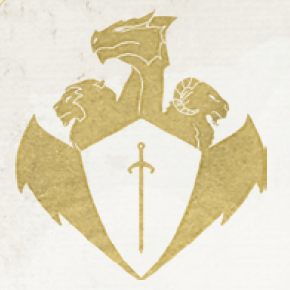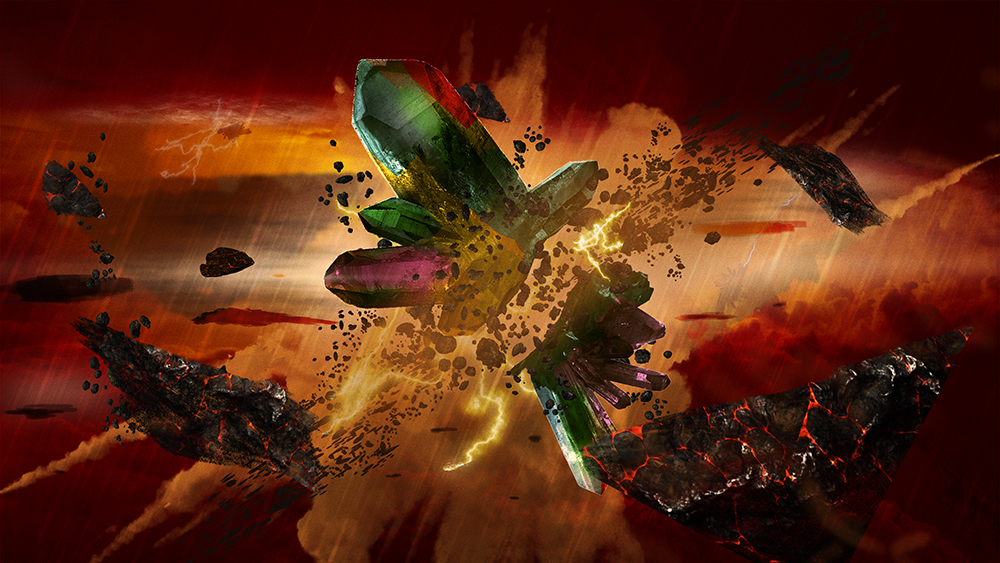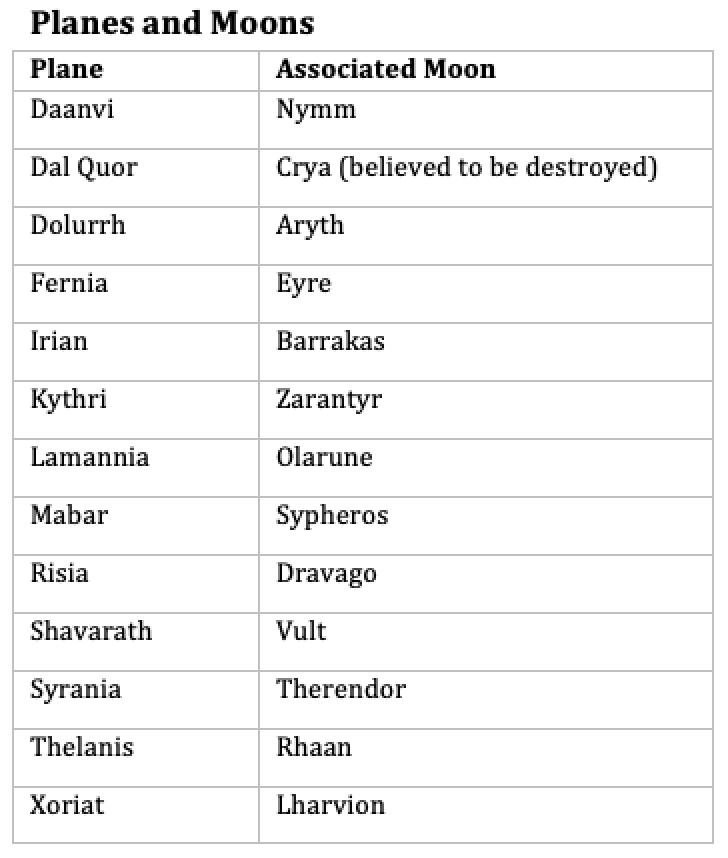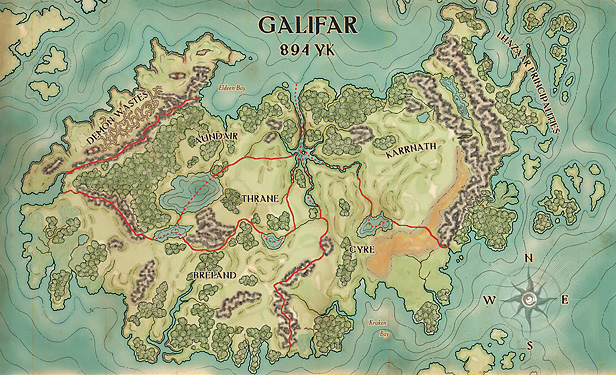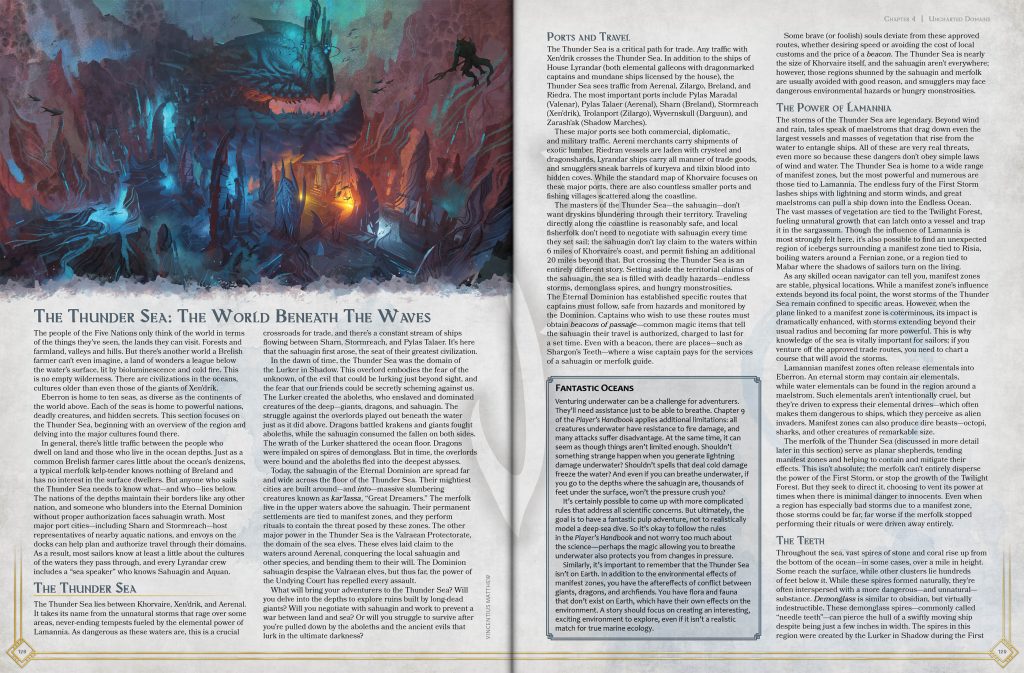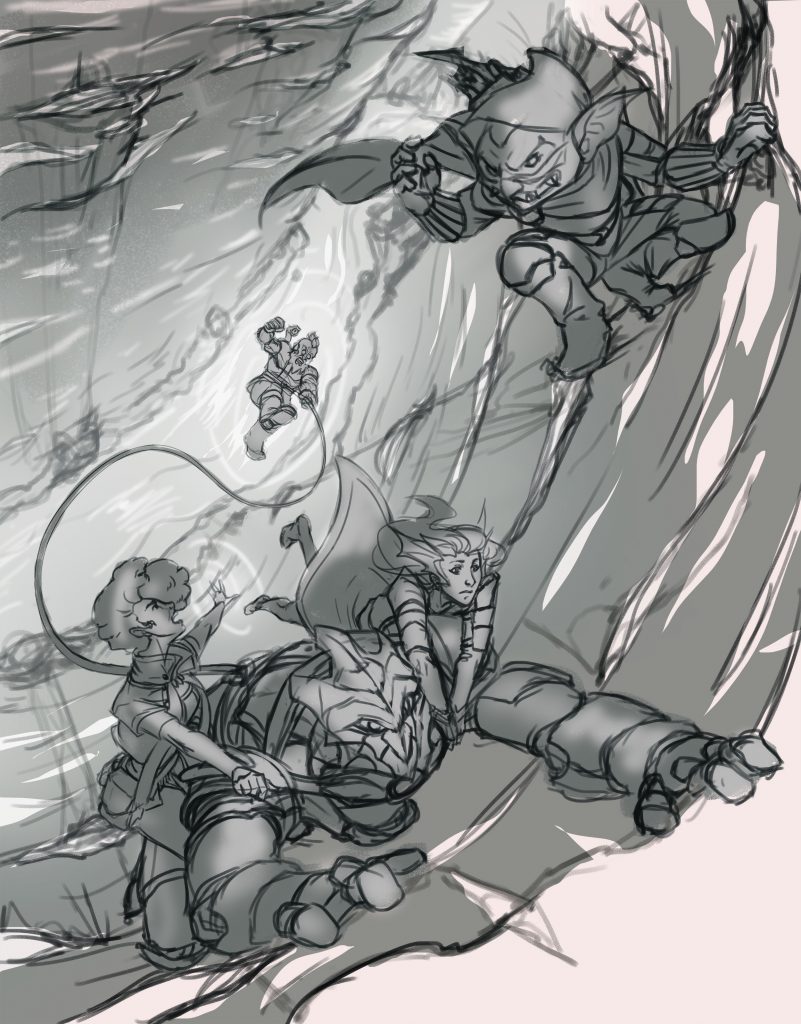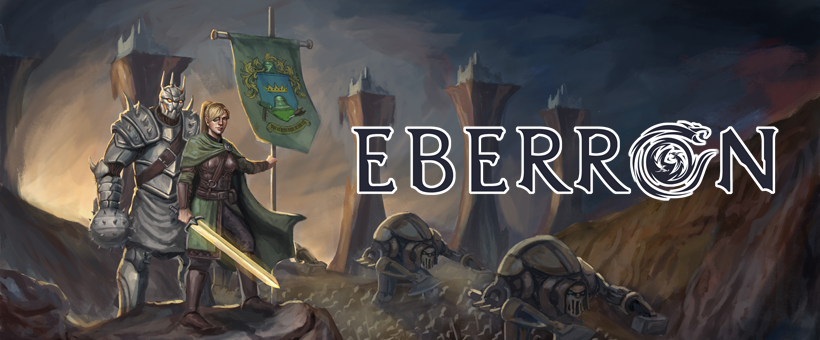
It’s hard to talk about dragonmarks and the dragonmarked houses without also discussing aberrant dragonmarks and the War of the Mark. I posted a sidebar article about Aberrant Dragonmarks not too long ago, but my Patreon supporters recently raised a number of questions recently about the aberrant champions of the War of the Mark, notably Halas Tarkanan.
For a quick refresher: Long ago aberrant dragonmarks were more widespread than they are today, and they were also more powerful than the common aberrant mark known today—the simple powers granted by the Aberrant Dragonmark feat. The dragonmarked houses—quite young at the time—used the fear of aberrant dragonmarks as a scapegoat, both as a cause that helped to unite the houses themselves and to strengthen public opinion that “true” dragonmarks were good, and aberrant dragonmarks were the foul touch of Khyber… and lest it go without saying, many members of the houses believed the tales they spread. There’s no cure for an aberrant dragonmark, and this led to mob violence and from there to more organized persecution on the part of the houses. “The War of the Mark” implies a conflict between two even sides, and this was anything but. Due to house propaganda, people with aberrant marks were feared and ostracized, and this was more of a witch-hunt than a war. However, as it drew on, a number of leaders emerged among the aberrants—people with the charisma to lead and the foresight to plan, and with enough raw power that even the houses came to fear them. These leaders gathered bands of aberrants around them and sought to establish sanctuaries or hold off her houses.
The band whose exploits are best known was tied to three powerful aberrants. Halas Tarkanan was known as “The Earthshaker,” and his aberrant mark gave him power over elemental forces. His two greatest allies were known only by titles. The Lady of the Plague controlled vermin and disease, and was widely seen as the most dangerous of the aberrants. The Dreambreaker wielded vast psychic power and could crush lesser minds. Beyond his personal power, Tarkanan was a master strategist. Under his guidance, they seized the city of Sharn (which far smaller than it is today) and established it as a haven for the aberrant. But the houses had superior numbers, resources, and discipline. Sharn was besieged, and when it became clear that the battle was lost, Halas determined to make the victory as costly as possible. The three aberrant leaders gave their lives and poured their essence into terrible death curses. Little is known about the impact of the Dreambreaker’s curse. But Tarkanan’s curse shook the earth and collapsed the old towers, while the Lady of the Plague spread deadly disease throughout the ruins and called up strange forms of vermin. Those few soldiers who survived the attack lingered just long enough to carry the plagues to their comrades; even in death, the Lady of the Plague inflicted a lasting blow on the house forces. Today it’s her curse that is still felt. The region known as “Old Sharn” is sealed off because it’s believed that her plagues still linger in the depths, and there are forms of vermin found in Sharn that aren’t seen anywhere else in Khorvaire.
In considering the aberrant leaders, there’s a few things to bear in mind. The first is that they possessed aberrant marks of a level of power not yet seen in the present day—aberrant dragonmarks comparable to the Siberys dragonmarks of the houses. But beyond that, just like the house of today, their greatest powers came not simply from their dragonmarks, but from tools that focused and amplified the powers of these marks. Tarkanan channeled his power through a gauntlet he called the Earth’s Fist. The Dreambreaker used the Delirium Stone to focus his mental energy. And the Lady of the Plague wore a cloak she called Silence. So it’s not that Halas destroyed a city with his mark alone; just Cannith has creation forges and Lyrandar has its storm spires, it was the Earth’s Fist that allowed Tarkanan to level Sharn. And while these leaders died, it’s quite possible these artifacts survived. Each one was designed to interface with the unique marks of the champions who carried them, but it’s possible that a modern creature with a similar aberrant dragonmark could attune to one of these deadly artifacts.
So who were these aberrant champions? The short answer is that no one knows for sure. They lived over fifteen centuries ago, most were outcasts, and of course, the winners write history. Any serious scholar has to eliminate the propaganda circulated by the houses at the time—stories that present Tarkanan and his allies as monsters. Sivis propaganda suggested that Tarkanan was an avatar of the Devourer—a story supported by his elemental power—sent to bring suffering to innocents. Other tales claimed that all of the aberrant leaders were “lords of dust,” lingering fiends from the Age of Demons that delighted in chaos and bloodshed. So the short form is that it’s hard to be certain of anything and that adventurers could always discover new answers over the course of their adventures. What follows is the answer in my Eberron—the truth that could be found by a diligent sage—but that doesn’t mean it’s the absolute truth.
Halas Tarkanan
Halas Tarkanan was the son of Ilana Halar d’Deneith, an heir of House Deneith, and Grayn Tarkanan, a mercenary licensed by the house. Ilana commanded the mercenary regiment Grayn served in, and the two fell in love. When Grayn developed an aberrant dragonmark his contact with the house was severed and Illana was ordered to end her relationship with him. She refused and was excoriated. Ilana and Grayn left Korth behind, working as independent mercenaries in southern Wroat (the region that’s now Breland), where Deneith had yet to fully establish its presence.They served the self-appointed King Breggor III in a series of bitter conflicts between Wroat lords, and Halas was raised on the battlefield. Ilana taught her son the arts of war, and he was as capable as any Deneith heir. A Sivis account says that Halas murdered his parents, but the truth is more complex. In this time the houses were expanding their whispering campaign against aberrants, and House Deneith was expanding its operations in Wroat. Deneith promised to support Breggor, but first he had to rid himself of his aberrant and excoriate champions. Illana’s troop was sent into an ambush and trapped on a now-forgotten bridge over the Dagger River. They were surrounded by enemies when Halas’s aberrant dragonmark manifested. Its power collapsed the bridge, killing both his family and their enemies, and Halas himself was presumed dead; the destruction of the bridge was held up as yet another example of the dangers posed by aberrant dragonmarks. But Halas survived.
There’s few concrete records of the next decade of Tarkanan’s life. Some say that he secretly made his way to Rekkenmark, and served in the armies of Karrnath; in these stories, some of his unmarked comrades in arms later joined his struggles in Wroat. Certainly, he eventually fought a one-man war against Breggor and House Deneith’s operations in Wroat, gaining greater control over his powers with each guerrilla attack. He obtained the Earth’s Fist during this time, presumably by working with the Tinker. He met the Lady of the Plague in this time, but none know exactly how. Within House Tarkanan, one story says that the Lady found Halas dying of infected wounds and saved his life; another tale says that the two were both sheltering in the same village during an aberrant purge. Whatever the truth, they were already partners when the houses and their supporters began executing aberrants.
Halas was a gifted tactician, and the Lady of the Plague seems to have been a persuasive speaker; together, they executed an exodus through southern Wroat, rallying aberrants from across the region around Sharn. The rest is history; in the novel The Son of Khyber, a contemporary says of Halas “I think he always knew how the struggle would end, but he was determined to give our people hope and to make the houses pay for the blood they spilled.”
So: what’s known of Halas Tarkanan? He was the child of a Deneith excoriate and hated House Deneith above all others. He was skilled with a sword, but his talents as a commander were more important than his skills with a blade. He was ruthless when he had to be, and was willing to make sacrifices when it was the only way to hurt his enemy. And not only did he possess an aberrant mark of great power, he knew techniques that allowed him to manipulate his mark in ways unknown in the present day… as shown by the “death curse” that leveled old Sharn. Many dragonmarks place a burden—physical or mental—on the bearer. There’s no records of what price Halas paid for his power, but some stories suggest that his mark may have reacted to his mood—that he was always calm, because his anger could shatter the world. But as with so much about him, this is largely conjecture. There are no records of him having children, but if any existed it’s likely he would have kept their existence as secret as possible. Certainly by the end of the War of the Mark, the houses claimed to have completely eliminated the “blood of Khyber”—but as as aberrant dragonmarks aren’t hereditary in the same way as true marks, it’s possible he could have had an unmarked child who slipped past the divinations of the Twelve.
The Lady of the Plague
If you have a moment, there’s someone I’d like you to meet. She grew up in village in Daskara, not far from the modern city of Sigilstar. She loved the country and taking care of the livestock. When she was 13, her family fell ill with a disease no one had ever seen before. They died, and the plague spread to the rest of the village and their stock. Only two things were unaffected: the rats and the girl. When everyone was dead, she fled to the town of Sarus. You’ve never heard of Sarus, because it doesn’t exist anymore. It was burnt by those who sought to keep the plague from spreading. The rats kept the girl alive, and were the only thing that kept her close to sane. In time she learned to control her power. Even so, she couldn’t bear the burden of the deaths on her conscience. She declared that the girl had died with her family. She was someone new, someone without a name. She was the Lady of the Plague.
This is the most detailed description of the Lady of the Plague, drawn from this (noncanon) article on aberrant dragonmarks. On a small scale, the Lady could use her mark to inflict effects similar to harm and insect plague. But her greater gift was the power to create virulent diseases—plagues that could spread across entire cities. However, she had no ability to cure the diseases she could create. Unleashing a disease was like setting a fire; it could spread farther and faster than she intended. She was one of the most infamous aberrants of the age; the destruction of Sarus was a regular feature in the propaganda of the Twelve, carrying the warning that sparing one aberrant could doom your entire city.
Halas Tarkanan was a strategist and a warrior, and is usually seen as the leader of the Wroat aberrants. But sages who dig deep will find that while Halas was the warrior, the Lady was the visionary—that it was her impassioned speeches that rallied the refugees when spirits were low, and she who convinced people to follow and fight alongside them. While Sivis accounts typically depict the refugees as all aberrants, the fact is that there were many unmarked people who joined the aberrant cause. Some were relatives or lovers of the marked, but others were compelled by the Lady’s words, and made the choice to stand by those innocents being hunted by the houses. Halas and the Lady rallied other oppressed people, and many Wroat goblins joined their cause. When the Twelve finally laid siege to Sharn, only about half of the people in the city had aberrant marks, but all chose to stand and fight.
It’s known that the Lady had unusual theories about the nature and purpose of aberrant dragonmarks. It’s possible she had some inkling of the Draconic Prophecy, but she may have simply believed that aberrant marks and those who carried them had a role to play in the grand order of things. There are no known recordings of her beliefs… but perhaps one of her journals remains hidden in Old Sharn, or even somewhere in Aundair.
Like Halas, the Lady of the Plague possessed the ability to enhance her power through her own pain, and her death curse lingers to this day. Her cloak Silence helped her contain her power and prevent accidental infection of innocents, but it also amplified her abilities.
The Dreambreaker
The Dreambreaker was a gnome born in what’s now Zilargo. His aberrant mark allowed him to shatter the minds of people around him and some accounts suggest that he could twist time and space. However, his power also affected his own perception of reality. It’s said that he believed the Wroat aberrants were actually fighting the Sovereigns, and that the houses and their mortal minions were simply manifestations of this greater cosmic struggle. He was devoted to the aberrant cause and his sheer power was a vital weapon in their arsenal, but his instability prevented him from leading forces on his own. Like the Lady of the Plague, the Dreambreaker was often featured in anti-aberrant propaganda; Sivis spread wild tales of his abilities to crush minds and claimed that he could murder innocent people in their dreams.
The Dreambreaker possessed a focus item called the Delirium Stone, presumably created by the Tinker. He is presumed to have died in the siege of Sharn, but he is known to have been fighting in a different tower than Halas Tarkanan and some accounts suggest that he planned to twist time, stealing the future from the houses… but nothing was ever heard from him following the destruction of Sharn.
The Tinker
Halas Tarkanan, the Dreambreaker, The Lady of the Plague, Kalara of the Ten Terrors, and more—the most infamous champions of the War of the mark all possessed artifacts that channeled and focused the powers of their aberrant marks. But where did these tools come from? Halas was no artificer, and the aberrants didn’t have the resources of House Cannith. Or did they? It’s recorded that Halas ascribed the Earth’s Fist to “the tinker,” and storytellers have used that to create a mysterious figure—an aberrant heir of House Cannith! Whose dragonmark allows them to consume or twist the enchantments of objects! Others say that this tinker must have been a fiend—able to create tools to channel the power of Khyber because they themselves were one of the true children of Khyber. Either of these are possible, but there is a simpler possibility: that “the tinker” may have been a term referring to a number of sympathetic artificers within House Cannith who opposed the War of the Mark and sought to aid their aberrant foes.
The true identity of the Tinker could be an interesting mystery to solve—especially if House Tarkanan starts receiving aberrant focus items in the present day. Are these gifts from the original Tinker, somehow preserved through centuries? Or is this the legacy of a movement in House Cannith—perhaps tied to the humble Juran line—that has hidden in the shadows of the house?
Why Does This Matter?
For centuries after the War of the Mark, aberrant dragonmarks were all but unknown. Over the age of Galifar they slowly began to return, but their powers were trivial in comparison to the might of Halas Tarkanan or the Lady of the Plague. Within the last century aberrant dragonmarks have been appearing at an unprecedented rate, and a few with greater power have been reported. Is this the work of the daelkyr? A sign that an overlord is close to breaking its bonds? Or could it be a manifestation of the Draconic Prophecy: could the aberrants have a vital role to play in the days ahead?
While there are no concrete mechanics for powerful aberrant marks, as with an dragonmark a player character could ascribe their class features to an aberrant dragonmark. A sorcerer’s spells could be drawn from their mark; a warlock could take their aberrant mark as their patron, perhaps even hearing it whisper or receiving strange dreams. Even a barbarian could say that their rage is the power of their aberrant mark. I personally played a character in a campaign who believed that he had inherited Halas Tarkanan’s mark, and that it was his destiny to rally and protect the aberrants of the present day. That’s one possibility: the idea that the essence of one of these champions could be reborn in the present. Another possibility is that the Dreambreaker could have been right all along; that he did have the power to twist time and space, and that he channeled the essence of the aberrants to the present day (a variation of this is explored in the old RPGA adventure “The Delirium Stone”). Alternately adventurers could encounter a ghost or some other legacy of one of these champions—or perhaps find a journal of the Lady of the Plague, containing strange insights.
General Q&A
Were aberrant marks always ostracized? When Cannith and Sivis began to rally the other bloodlines into the Houses, were mixed marks thought of as undiscovered new marks, or were their destructive abilities quickly categorized into the realm of dangerous and taboo?
There was certainly a time when aberrant marks weren’t as feared as they are today, let alone the crazed fear that drove the War of the Mark. We’ve called out that the houses actively fanned the flames of fear and built up that hatred for decades before the War of the Mark finally took place. But while it may not have been as intense, they were always feared, because as called out in the other linked articles, they ARE dangerous. The Lady of the Plague DID destroy multiple communities before learning to master her power—and there are many aberrants who never learn to master their powers. It was easy for the houses to amplify the fear because people were already afraid, and the houses encouraged this instead of working to bring people together. But there were also surely communities that refused to give into that fear—villages that were havens for those with aberrant dragonmarks. Such communities would have provided the bulk of the numbers in the Wroat exodus, both of marked and unmarked refugees; while the people in these communities stood together, they also knew that they couldn’t fight house forces.
Regarding why the marks weren’t seen as undiscovered new dragonmarks, and why they quickly became taboo, there’s two factors. Aberrant dragonmarks aren’t hereditary and don’t have a common appearance. Three marks that grant burning hands could all manifest in entirely different ways. It’s rare to find any two aberrant marks that are identical, let alone that resemble the “true” marks, so people were pretty quick to conclude that these weren’t just some undiscovered new mark. Beyond this, the issue is that not only is an aberrant mark not hereditary, manifesting an aberrant mark severs your connection to any other dragonmark. When the child of an Orien and Cannith manifests an aberrant mark, it also eliminates any possibility that their children could manifest the Mark of Making or Mark of Passage. As the houses were still working to build their numbers and the strength of their lines, this revelation was as significant a factor in banning inter-house liasons as fears of the mixed marks themselves.
How do you see the participation of the Houses that existed at the time playing out in the War of the Mark?
Part of the purpose of the war was to strengthen the ties between the newly minted houses—creating a common foe they could fight together. This was also a way to familiarize the people of Khorvaire with houses that had previously been limited to a particular region and to help them spread. There were houses that didn’t exist—Thuranni, Tharashk. The Mark of Detection had only just appeared, and it’s quite possible that Medani was formed during the war, as the hunt for aberrant marks would certainly have discovered this new true mark. But Phiarlan performed reconnaissance, Deneith provided the bulk of the soldiers, Cannith armed them, Jorasco healed them, Ghallanda supported them. Vadalis provided mounts to ride and beasts to track the foe. Sivis most likely focused on logistics and propaganda. In the adventure “The Delirium Stone” (EMH-7), adventurers encounter a squad of soldiers including Deneith infantry, a Phiarlan archer, and a Jorasco healer supporting the unit. Later encounters include a Vadalis magebred swarm and a Cannith construct.
Ghallanda is an interesting question. While I expected it was pressured to support the action and likely helped with supplies, I can definitely imagine individual Ghallanda heir providing sanctuary to aberrant refugees, holding their principles over the goals of the alliance.
In Dragonmarked it’s said that the Medani were originally thought to be aberrants, and that they were subsequently coerced into joining the Twelve.
It’s difficult for me to imagine that there was any significant length of time in which Medani were mistaken for aberrants. Aberrant dragonmarks and true dragonmarks are dramatically different. All true dragonmarks share the same general coloration, sizing, and overall design; the Mark of Detection is distinctly different from the Mark of Making, but at a DISTANCE it looks the same. Aberrant marks vary wildly in color and design. They aren’t hereditary and two marks that grant the same power may be dramatically different in appearance. Even if someone believed that despite looking just like a true mark that a mark was aberrant, the moment they saw that the person had a brother with the same mark they should know something was up. And remember that the Twelve were LOOKING for additional true marks; they called themselves “The Twelve” before they’d found twelve marks, because they were convinced there were others out there waiting to be found.So I have great trouble imagining a widespread series of events in which Medani were mistaken for aberrants. One or two minor incidents, sure, But even at a distance, if someone saw the blue-purple mark they likely wouldn’t say “No, wait, that’s not exactly like one of ours”—they’d say “Damn, that half-elf has a dragonmark! Who let a Lyrandar in here?”
With that said: The Mark of Detection manifested during the War of the Mark. So those who carried it lived alongside aberrants, and could easily have been caught up in the purges that targeted them. As such, I can see many Medani having sympathy for the aberrants and choosing to stand alongside them: “Why do you treat me differently than her, just because my mark is blue and the same as my father’s?” So I think it’s quite plausible that a number of early Medani rejected the Twelve and actually fought alongside the aberrants; but that’s not the same as being mistaken for aberrants. And I do think that overall, the Medani were pressured—even threatened—by the other houses to join the Twelve, and that this underlies their attitude toward the Twelve to this day.
That’s all I have time for now. Have you used aberrant dragonmarks or the champions of the War of the Mark in your campaign? If so, share your stories below. Thanks as always to my Patreon supporters, who keep this site going; supporters are currently voting on the topic of the next major article (Sarlona is currently in the lead!).

